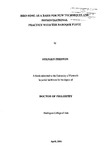Bird song as a basis for new techniques and improvisational practice with the baroque flute
| dc.contributor.author | Preston, Stephen | |
| dc.contributor.other | Faculty of Arts, Humanities and Business | en_US |
| dc.date.accessioned | 2011-10-04T10:09:33Z | |
| dc.date.available | 2011-10-04T10:09:33Z | |
| dc.date.issued | 2004 | |
| dc.identifier | Not available | en_US |
| dc.identifier.uri | http://hdl.handle.net/10026.1/854 | |
| dc.description | Merged with duplicate record 10026.1/2753 on 03.04.2017 by CS (TIS) | |
| dc.description.abstract |
Subsequent to a period of training as a flautist, I ultimately specialised professionally on the baroque flute. Consequently, a significant part of my research for a PhD was practice-led. My later career; concerned with dance and choreography, represented a widening and diversification of my interest in music in particular, and the allied arts in general. This was (and continues to be) paralleled, however, with a substantial research-interest in aspects of the performance of music and its potential interconnection(s) with modalities of speech. However, my own research commenced with a strong desire to discover new performance techniques on the baroque flute. Earlier performer/composers on the instrument explored, documented and analysed new ways of performing on the instrument. This research continues that form of practice-led investigation. This investigation has been centred on performance-experiments of an often improvisatory kind, but by the time of its completion, I too became a performer/composer on the instrument. The research became focussed on a critical and analytical study of birdsong. Birdsong offers a degree of pitch and timbral variation of phenomenal power. My research questioned and interrogated the structure; modes of delivery and sonorities in birdsong because I wanted to devise a new method of playing that might approach these avian sonic possibilities and by absorbance, produce a new musical language on the baroque flute. Previous ornithological writings (Thorpe; Armstrong, Hartshorne, et at) have frequently considered birdsong as a form of music. Thus, my research examined documentary outcomes from research into birdsong in the form of analysis of recordings, and critical scrutiny of sonographs. Birds `perform' in varying degrees of tonal, atonal and microtonal systems. The research paralleled these treatments of pitch and harmony. It also addressed issues of structure, dynamics, timbre, rhythm and the physical aspects of delivery with the intention of devising a new `method' for the generation of a new music for the instrument. The research has of course been polymodal and interdisciplinary. It consisted of the following methodological, practical and theoretical domains, namely: • critical and analytical readings in the science of ornithology; especially birdsong • critical and analytical readings in historical models for performance on the baroque flute; • field-studies in the form of recordings and notational transcriptions (via Messiaen and Cowie, et al) of birdsong; • practical experiments as a soloist (improviser) together with collaborative, experimental and practical research with an ensemble and/or another baroque flautist. The purpose of this research was to find new techniques for contemporary musicians, accompanied by a body of writing that embodies a kind of treatise on the instrument with potential for use by other contemporary musicians. Thus, the written thesis, together with recordings of experiments, improvisations and concert-performance should be considered as a collective body of new knowledge in relation to performance on the baroque flute in particular, but with potential for use by other (or all) musical instruments. My findings are that: • a new performance technique is required as a result of a study of birdsong and with the effect of producing a vastly extended repertoire of effects and pitch frequencies on the instrument; • this new technique generates a new musical language particularly in respect of treatments of microtonality; new breathing and fingering techniques; • the technique is transferable by teaching and demonstration to other performers and of potential use for contemporary composers writing for the instrument; • these new techniques were enhanced (if not made entirely possible) by field-studies and cross-disciplinary (arts/sciences) and illustrate the potency of cross-field research in the generation of new music. The principal outcome of my research was the development of a system of playing that has now been named by me as ecosonic performance. It is so-named, because the performance-techniques developed are based on a phenomenological study of the ecology of sound in birds; themselves already ecosonic performers. This written thesis is a documentation of my modalities of research, experimentation and practice. It is designed in the form of a commentary/treatise, and should be considered as a form of `primer', not only for the baroque flute, but also for the further investigation of the performance-capabilities of any musical instrument. | en_US |
| dc.language.iso | en | en_US |
| dc.publisher | University of Plymouth | en_US |
| dc.title | Bird song as a basis for new techniques and improvisational practice with the baroque flute | en_US |
| dc.type | Thesis | |
| dc.identifier.doi | http://dx.doi.org/10.24382/4005 |
Files in this item
This item appears in the following Collection(s)
-
01 Research Theses Main Collection
Research Theses Main


